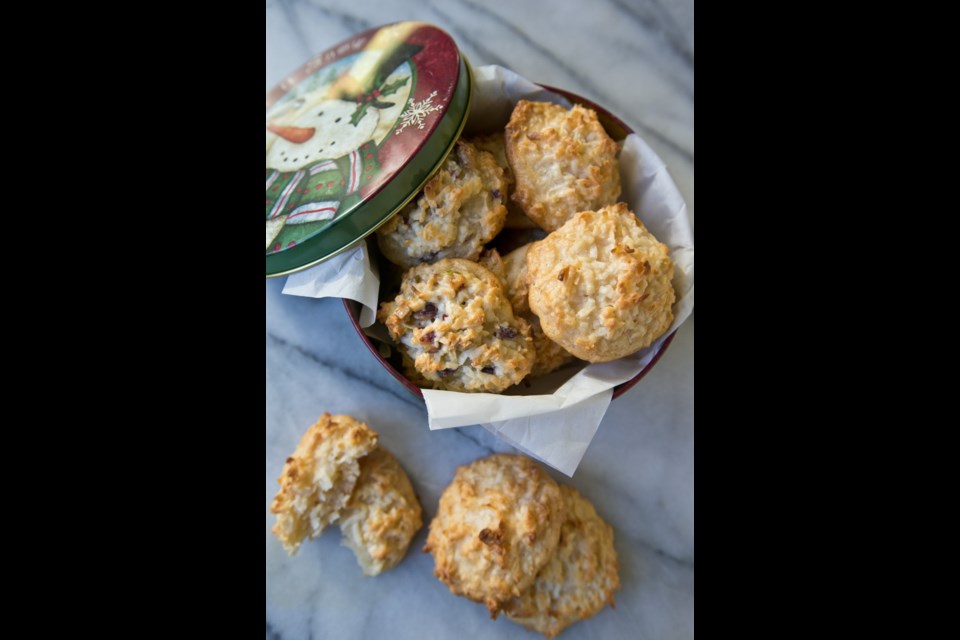 Sweet, chewy, sometimes crunchy but always delicious, it鈥檚 no wonder many people can鈥檛 resist a macaroon when they spot one on a cookie tray.
Sweet, chewy, sometimes crunchy but always delicious, it鈥檚 no wonder many people can鈥檛 resist a macaroon when they spot one on a cookie tray.
This type of cookie has been drawing that kind of attention for some time.
According to a few sources, macaroons date back to a ninth-century Italian monastery, where monks were said to have modelled them in the shape of their belly buttons.
According to the Oxford Companion to Food, the names macaroon and macaroni are derived from the old Italian word maccare, which means to pound. That鈥檚 how ingredients were once blended together way back before electricity was invented.
In the case of the first macaroons, almonds were pulverized into a paste that was sweetened and used to make these cookies, which were sometimes also referred to as biscuits or cakes.
Over time, a basic recipe developed for macaroons in which the almond paste was mixed with beaten egg whites (meringue), creating a flourless and unleavened (no yeast, baking powder or soda) cookie. This type of macaroon is still made in Italy, with the smaller version of it called amaretti.
From Italy, macaroons made their way to other parts of Europe. Because they were unleavened, they became popular in Jewish communities. They were a sweet treat that could be enjoyed at Passover, when leavened items are not eaten.
In continental Europe, again, particularly in Jewish communities, a coconut version of macaroons began to appear in which the almond paste was replaced with desiccated (dried, shredded) coconut.
Coconut macaroons also became popular in England and other parts of the Commonwealth, including Australia and Canada, and in other places where Europeans settled, such as the United States.
Before I tell you about the types of macaroons made in those places, let me wind the clock back and tell you that, centuries ago in France, an offshoot of the macaroon developed and had a similar-sounding name, with a slightly different spelling. It was called a macaron, and although it also contained almonds and egg whites, it was a more refined-looking creation that is now often coloured, piped, baked and made by sandwiching two small cookies together.
Back to other types of macaroons made in England and North America: Coconut versions began to be accented in other ways, such as by placing a maraschino cherry in the centre of the cookie or dipping it in chocolate. Instead of almond, other nuts were used, such as pecans.
Also, in some North American coconut macaroon recipes, a bit of flour was added to help hold the ingredients together. And convenience products, such as canned sweetened condensed milk, were used as a quick and convenient way to moisten and sweeten the coconut mixture before baking.
This easy-to-make cookie certainly has an interesting history, and with so many variations now being made (I found at least 60 recipes), it was very difficult for me to choose what macaroon recipes to publish today.
In the end, I decided to be selfish and go with my two favourite types: a more old-school, European-style almond macaroon, and a dense and chewy North American-style coconut macaroon. I shared them with my neighbours and the macaroons didn鈥檛 last long, confirming that people still can鈥檛 resist them when spotted on a cookie tray.
Almond Macaroons
Slightly crunchy, almond-rich and sweet, these cookies go great with a rich cup of coffee or shot or two of espresso.
Preparation time: 25 minutes
Cooking time: 15 minutes
Makes: 16 cookies
1 cup whole, blanched almonds (see Note)
2/3 cup granulated sugar
1/8 tsp salt
1 large egg white
1/4 tsp almond extract
48 whole, blanched almonds
oicing sugar, to taste (optional)
听
Place the 1 cup almonds, granulated sugar and salt in a food processor. Pulse until the almonds are very, very finely chopped and well combined with the sugar. Add the egg white and almond extract and pulse until you have a sticky, cookie dough-like mixture that holds together.
Preheat the oven to 350 F (use regular heat, not convection). Line a large baking sheet with parchment paper.
Divide the dough-like mixture in half, and then pull each half into eight equally pieces. Now roll each piece into a small (about 1-inch) ball and set on the baking sheet, spacing each cookie about 2 inches apart. Flatten each cookie into 1/2-inch thick disc. Now gently press three whole almonds on top of each cookie.
Bake the cookies in middle of oven 15 minutes, or until very pale golden. Set the baking sheet on a baking rack. Let the macaroons cool on the baking sheet two hours. Transfer macaroons to a tight-sealing container until ready enjoy.
If desired, and only if so, you could dust the macaroons with a little icing sugar just before enjoying.
Note: Blanched (skinned) whole almonds are sold in the baking aisle and bulk food section of supermarkets.
听
Coconut Macaroons
Sweet, delightfully chewy cookies loaded with coconut. In December, when invited to a party, pack these cookies in festive tins and give them to the host as an edible gift.
Preparation time: 25 minutes
Cooking time: 18 to 19 minutes, per sheet
Makes: 24 cookies
听
2 (200 gram) bags sweetened flaked coconut
1/3 cup all-purpose flour
1/4 tsp salt
1 (300 mL) can sweetened condensed milk
2 tsp pure vanilla extract
1 large egg white
听
Preheat the oven to 350 F (use regular heat, not convection). Line two large baking sheets with parchment paper.
Place the coconut, flour and salt in a bowl and mix well to combine. Pour the condensed milk into the bowl, using a small spatula to ensure you get every drop of it. Add the vanilla and mix until a very thick coconut mixture forms.
Place the egg white in another bowl and whip until stiff peaks form. Fold and mix the beaten egg white into the coconut mixture.
Divide and mound, in fairly neat rounds, two tablespoon amounts of the cookie mixture on one of the baking sheets, spacing each cookie about 3 inches apart. (You should end up with 12 cookies on the baking sheet.)
Bake that sheet of cookies in the middle of the oven for 18 to 19 minutes, or until nice and golden around the edges and top. While the first sheet of cookies bake, divide and mound the remaining cookie mixture on the second baking sheet and bake it after the first sheet is done.
Cool the cookies on a baking rack two hours, and then store in an airtight container until ready to enjoy.
Eric options: In today's photo of these cookies you'll see some of the coconut macaroons are flecked with bits of pistachios and cranberries. To make that version of this cookie, which are baked the same way, set 3 Tbsp of shelled, unsalted pistachios, and 3 Tbsp dried cranberries, on a work surface and chopped them into fairly small pieces. Add them to the flaked coconut, flour and salt, before mixing in the condensed milk, vanilla and egg white.
Eric Akis is the author of The Great Rotisserie Chicken Cookbook (Appetite by Random House). His columns appear in the Life section Wednesday and Sunday.



